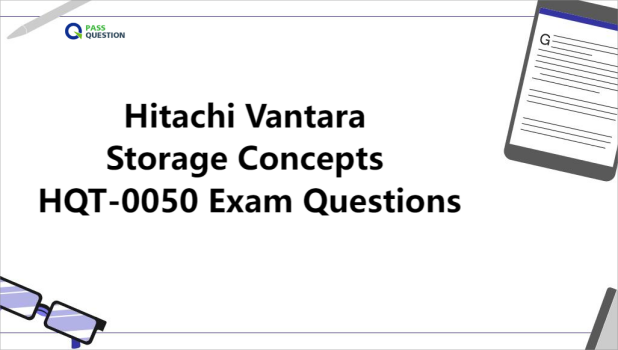Hitachi Vantara Storage Concepts HQT-0050 Exam Questions
The best approach to passing your Hitachi Storage Concepts HQT-0050 exam is to challenge and continuously improve your knowledge and understanding of the subject matter. To assist with this, PassQuestion offers the latest Hitachi Vantara Storage Concepts HQT-0050 Exam Questions, which are meticulously crafted based on actual exam questions and answers. These resources allow you to thoroughly test your knowledge and skills, providing you with a comprehensive understanding of what to expect in the exam. Utilizing these well-designed Hitachi Vantara Storage Concepts HQT-0050 Exam Questions can significantly enhance your chances of passing the Hitachi Vantara Qualified Associate - Storage Concepts exam easily and confidently.

Hitachi Vantara Qualified Associate - Storage Concepts
This vendor-neutral test will validate that the successful candidate knows storage technology and concepts. The test covers data management and storage systems, components and technologies, networking, business continuity and replication, virtualization, file-and-content management, performance, and protocols. This vendor-neutral exam is for anyone interested in storage technology. IT professionals seeking knowledge on storage and junior IT professionals looking to carve out a career path and focusing on storage are ideal candidates for this exam. College and university students and recent graduates will gain a head start on their IT careers by earning this Storage Concepts qualification.
Hitachi HQT-0050 Exam Information
Exam Type: Qualification
Format: Non-proctored, openbook exam
Credential: Hitachi Vantara Qualified Associate – Storage Concepts
Validity: 3 years
Delivery: Kryterion Webassessor System
Questions: 35
Passing Score: 65%
Duration: 60 minutes
Cost: US $75 or equivalent inlocal currency (plus localtax, depending on location)
Test Objectives
Section 1 Introduction to data storage
1.1 Describe the different types of data.
1.2 Explain a storage system’s view of data.
Section 2 Storage components
2.1 Identify the major components of a storage system.
2.2 Identify different RAID technologies.
Section 3 Storage networking and security
3.1 Describe networking components.
3.2 Describe network topologies.
3.3 Describe the SAN architecture.
3.4 Describe the NAS architecture.
Section 4 Business continuity and replication
4.1 Describe data backup and data replication concepts.
4.2 Identify in-system replication techniques and benefits.
4.3 Identify remote-replication techniques and benefits.
4.4 Describe data center replication strategies.
Section 5 Virtualization of storage systems
5.1 Identify storage virtualization techniques.
5.2 Describe tiered-storage environments.
5.3 Describe thin-provisioning concepts.
5.4 Describe controller-based virtualization.
Section 6 Archiving
6.1 Identify files, objects, and metadata.
6.2 Identify archiving solutions and strategies.
Section 7 Storage system administration
7.1 Describe storage management operations.
Section 8 Performance tuning and optimization
8.1 Articulate storage system performance concepts.
8.2 Describe performance monitoring and reporting tools.
Section 9 Business Challenges
9.1 Describe the types of storage demands in today’s marketplace.
9.2 Identify storage issues and data center infrastructure challenges.
9.3 Describe ways to achieve energy-efficient, ecologically aware storage implementations.
View Online Hitachi Vantara Qualified Associate - Storage Concepts HQT-0050 Free Questions
1. What is the purpose of load balancing in storage systems?
A. To optimize system performance
B. To improve data security
C. To reduce storage costs
D. To increase storage capacity
Answer: A
2. Which of the following can storage system administrators do to improve system performance?
A. Add more storage capacity
B. Upgrade network routers
C. Configure RAID settings
D. Implement load balancing
Answer: D
3. What is the role of storage system administrators in performance tuning and optimization?
A. Developing software applications
B. Configuring network routers
C. Monitoring system performance
D. Managing user accounts
Answer: C
4. Which of the following is an example of unstructured data?
A. Sales figures in a spreadsheet
B. Customer names and addresses in a database
C. Email messages
D. Social media posts
Answer: D
5. What is an archiving strategy?
A. A plan for creating redundant copies of data
B. A plan for preserving data for long-term storage and retrieval
C. A plan for compressing data to save storage space
D. None of the above
Answer: B
6. When is it appropriate to use the "New Installation" procedure for VSP 5000 storage systems?
A. When performing routine maintenance on a storage system
B. When upgrading an existing storage system
C. When setting up a new storage system for the first time
D. None of the above
Answer: C
7. Which of the following is a storage virtualization technique?
A. Storage Area Network (SAN)
B. Network Attached Storage (NAS)
C. Solid State Drive (SSD.
D. Redundant Array of Inexpensive Disks (RAID.
Answer: A
8. Which of the following is NOT a supported Disk Adapter for VSP 5000 systems?
A. GXA 2700
B. GXA 5700
C. GXA 7700
D. GXA 9700
Answer: B
9. Which two characteristics of WWN zoning on a storage system are correct? (Choose two.)
A. It applies a virtual WWN to all servers on a storage port.
B. It connects a number of hosts to a storage port.
C. It controls a server's access to a storage port.
D. It permits a server to access all storage mapped to a port.
Answer: B, C
10. What is the purpose of performance tuning and optimization in storage systems?
A. To increase storage capacity
B. To improve data security
C. To enhance data accessibility
D. To improve system speed and efficiency
Answer: D
- TOP 50 Exam Questions
-
Exam
All copyrights reserved 2025 PassQuestion NETWORK CO.,LIMITED. All Rights Reserved.

